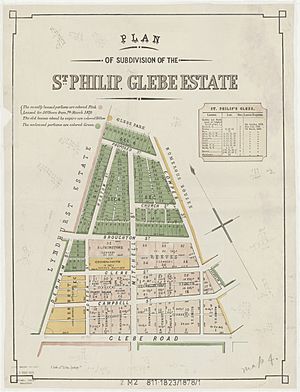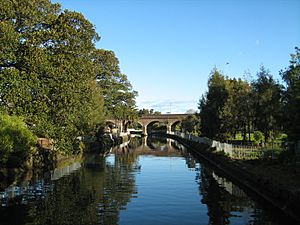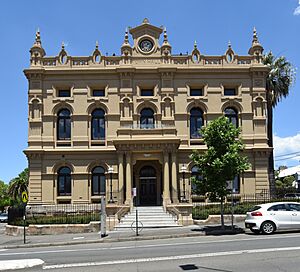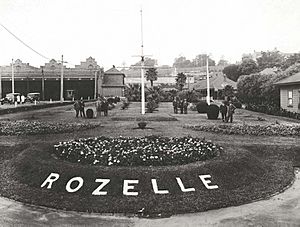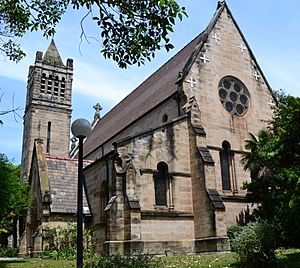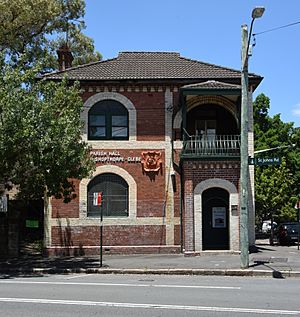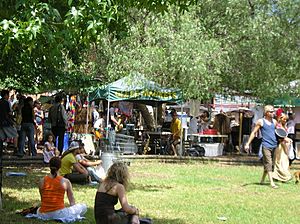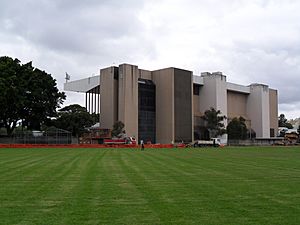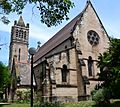Glebe, New South Wales facts for kids
Quick facts for kids GlebeSydney, New South Wales |
|||||||||||||||
|---|---|---|---|---|---|---|---|---|---|---|---|---|---|---|---|
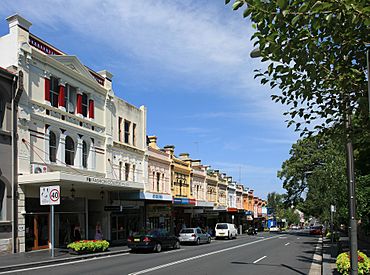
Glebe Point Road
|
|||||||||||||||
| Postcode(s) | 2037 | ||||||||||||||
| Elevation | 31 m (102 ft) | ||||||||||||||
| Area | 1.8 km2 (0.7 sq mi) | ||||||||||||||
| Location | 3 km (2 mi) south-west of Sydney CBD | ||||||||||||||
| LGA(s) | City of Sydney | ||||||||||||||
| State electorate(s) | Balmain | ||||||||||||||
| Federal Division(s) | Sydney | ||||||||||||||
|
|||||||||||||||
Glebe is a lively suburb located in the inner-western part of Sydney, in New South Wales. It's about 3 kilometers (2 miles) southwest of the main city center, known as the Sydney CBD. Glebe is part of the City of Sydney area.
The suburb is surrounded by water on its northern side, with Blackwattle Bay and Rozelle Bay, which are parts of Sydney Harbour. To the east, you'll find Ultimo, and to the west are Annandale and Forest Lodge. The southern edge of Glebe is marked by Parramatta Road and Broadway.
Contents
History of Glebe
The name 'Glebe' comes from the word "glebe," which means land owned by the Anglican Church. This land was a gift of 400 acres (160 hectares) given by Governor Arthur Phillip to Reverend Richard Johnson in 1790. Reverend Johnson was the chaplain for the First Fleet, the ships that brought the first European settlers to Australia.
In the 1800s, a famous architect named Edmund Blacket lived in Glebe. He built his family home, Bidura, on Glebe Point Road in 1858. He also designed St John's Church, which was built between 1868 and 1870.
Glebe was once home to a professional rugby league team called the Glebe Dirty Reds. They started playing in 1908 at Wentworth Park. The team was one of the first in Australia's rugby league history, but they stopped playing in 1930.
In the 1970s, a group of people started Australia's first women's shelter, the Elsie Refuge, in an empty house on Westmoreland Street. This was important because many houses in the area were left empty due to government plans for a new freeway. However, these plans were stopped by community protests, which saved many homes and parklands in Glebe.
Original Plants
The area originally had a type of forest called the Sydney Turpentine-Ironbark Forest. You can still see an old Ironbark tree growing at St John's Anglican Church today.
Cool Places to See
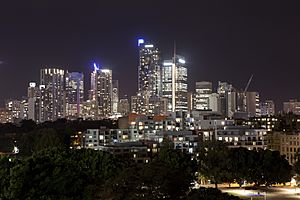
Glebe has many interesting landmarks and historic buildings:
- Glebe Town Hall: This beautiful old building was the main office for the Glebe council from 1880 to 1948. Today, it's a popular community hall used for concerts, parties, and meetings.
- Rozelle Tram Depot: Built starting in 1904, this was once the biggest tram depot in Sydney. Trams stopped running from here in 1958. It used to employ up to 650 people. Today, it still holds some old trams, some from the 1930s.
- Sze Yup Temple: Located on Edward Street, this Chinese temple was first built in 1898 by Chinese immigrants. It's still used today and is a very important heritage site. The current building was built in 1955 after an earlier one was destroyed by fire. It was damaged by another fire in 2008 but has since been rebuilt.
- Bellevue: This historic house in Blackwattle Park was built in 1896. It has been restored and now serves as a café.
- Bidura: Built in 1857, this house on Glebe Point Road was the family home of architect Edmund Blacket.
- St Scholastica's College: This school moved to its current site in 1901. The main building, Toxteth Park, was originally the home of George Allen, who later became the Lord Mayor of Sydney.
- Lyndhurst: This grand mansion was built between 1834 and 1837 for Dr. James Bowman. It was designed by the famous architect John Verge. It was almost torn down for a freeway but was saved by public protests.
- Johnstons Creek: This creek flows through Glebe and empties into Rozelle Bay. You can see it near Bicentennial Park.
- Glebe Jubilee Fountain: This fountain was put up in 1909 to celebrate 50 years of Glebe being its own municipality (local government area).
- St John's Glebe: Also known as St John's Bishopthorpe, this church opened in 1870. Its tower was added later in 1909.
- St John's Parish Hall Glebe: Built in 1870, this hall was used as a hostel during World War II for soldiers visiting Sydney.
Who Lives in Glebe?
In 2021, about 11,680 people lived in Glebe.
About 3.3% of the people living here are Aboriginal and Torres Strait Islander. Many young people attend school or university: 13.5% are in primary school, 10.8% in secondary school, and 44.5% are in university or technical college.
Most people (57.0%) were born in Australia. Other common birthplaces include England (4.4%), China (4.0%), and New Zealand (2.7%). English is the main language spoken at home by 68.2% of residents. Other languages include Mandarin (4.4%) and Vietnamese (2.7%).
When it comes to religion, 51.6% of people said they had no religion, and 15.6% were Catholic. Most homes in Glebe are semi-detached (like townhouses) or apartments. Many homes (61.4%) are rented.
Fun Things to Do
Shops, Restaurants, and Cafés
Glebe Point Road is the main street in Glebe. It's famous for its unique shops, cozy cafés, and a wide variety of restaurants. You can find Indian, Thai, Italian, Nepalese, and Dutch-Indonesian food here.
Broadway Shopping Centre is a large mall built where the old Grace Brothers department store used to be. It has many shops, a food court, and a cinema.
Glebe also has a very popular market every Saturday at Glebe Primary School. Here, you can buy arts, crafts, clothes, and delicious food. It's known for its unique and alternative goods, including both new and second-hand items.
Sports and Fun
Wentworth Park, located near the border with Ultimo, has a track for greyhound racing.
If you like skateboarding, there's a mini skateboarding ramp in Bicentennial Park. The Balmain South Sydney Cricket Club plays at Jubilee Oval in Glebe. The Glebe Dirty Reds rugby league team also plays in the Ron Massey Cup.
Learning in Glebe
Glebe has several schools for different ages. These include Glebe Public School, St James Catholic School, and Forest Lodge Public School. St Scholastica's College is also in Glebe. The Blackwattle Bay Campus of Sydney Secondary College is on the site of the old Glebe High School. Tranby Aboriginal College, which helps Aboriginal people with education, is located in a historic house called Tranby.
Getting Around
The Inner West Light Rail has two stops in Glebe: Glebe and Jubilee Park. You can get to Central railway station in less than 20 minutes by light rail.
There are also several bus routes that run through Glebe. Route 431 goes from Martin Place to Glebe Point, and route 433 goes from Railway Square to Balmain via Glebe Point Road. Route 370 connects Glebe Point to Coogee, passing through Newtown and the University of New South Wales.
Homes in Glebe
Many of the houses in Glebe are from the 1800s and have been beautifully restored. The area is popular with people who work in the city and students because it's close to the CBD and universities like the University of Sydney, the University of Technology Sydney, and the University of Notre Dame Australia. Glebe is also a popular spot for backpackers because of its cafes and bars.
Government-Provided Housing
In the southeastern part of Glebe, there's an area called the Glebe Estate. These are homes provided by the government for people who need affordable housing. They include Victorian-style terrace houses and small apartment buildings. This area has one of the largest populations of Aboriginal people in Sydney.
Historic Places Listed
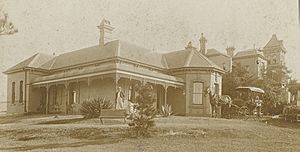
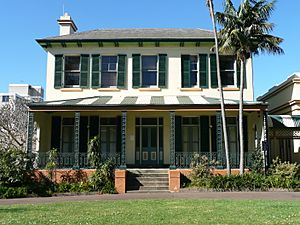
Glebe has many places that are protected because of their history. Here are some of them:
- 55–57 Leichhardt Street: Bellevue, Glebe
- 160 Bridge Road: Reussdale
- 281–285 Broadway: University Hall and Cottages
- 61 Darghan Street: Lyndhurst, Glebe
- 24 Ferry Road: Rothwell Lodge and Factory
- 266 Glebe Point Road: Monteith, Glebe
- 357 Glebe Point Road: Bidura
- 53 Hereford Street: Hereford House
- 13 Mansfield Street: Tranby, Glebe
- Victoria Road: Sze Yup Temple
- Wentworth Park, Jubilee Park, Johnstons Creek: Glebe and Wentworth Park railway viaducts
- Metropolitan goods railway: Pyrmont and Glebe Railway Tunnels
Other important historic buildings include:
- St John's Anglican Church, Glebe Point Road
- Glebe Court House, Talfourd Street
- Glebe Police Station, Talfourd Street
- Former Glebe Town Hall, St John's Road
- Former Glebe Post Office, Glebe Point Road
- Emslee, Mansfield Street
- Margaretta Cottage, Leichhardt Street
- Hartford, Glebe Point Road
- War Memorial, Glebe Point Road
Famous People from Glebe
Many well-known people have lived in Glebe, including:
- Sir Edmund (Toby) Barton (1849–1920), Australia's first Prime Minister.
- John Borghetti, a leader in the aviation industry.
- Sir John Sydney James Clancy (1895–1968), a judge.
- Eva Cox, an author and activist.
- Lucy Eatock (1874 – 1950), a political activist.
- Tim Ferguson, a comedian and musician.
- Sir Norman Thomas Gilroy (1896–1942), a Catholic cardinal.
- Ross Gittins, an economist and journalist.
- Stan Grant, a television presenter.
- Bessie Guthrie (1905–1977), a designer and campaigner for children's rights.
- Tracey Holmes, a sports broadcaster.
- James Francis (Frank) Hurley (1889–1962), an adventurer and photographer.
- Maynard, a broadcaster and entertainer.
- Reg Mombassa, a musician and artist.
- James Bradfield Moody, an author and engineer.
- Ernest Ridding (1927–2001), known locally as 'The Fridge Man' for his community service.
- Patricia Easterbrook Roberts (1910–1987), a floral designer.
- Leigh Sales, a television presenter and author.
- Toni Collette, an actress, who lived in Glebe until she was six.
Images for kids



